There is so much content flying around on the internet that it’s challenging for brands to stand out through all the noise. When you post something, you never know if it’s reaching the right audience at the right time.
If only there were a way to reach people with characteristics of your ideal audience across a platform that has over 2.7 billion users.
Oh wait, there is.
Facebook is no longer just a tool for seeing what your grandma is up to. (She’s doing fine BTW; she won $18 at bingo yesterday.) Facebook ads are a goldmine for marketers—if they’re used strategically.
How Do Facebook Ads Work?
Facebook ads work by cutting through the noise and showing your ad on Facebook users’ news feeds. Based on Facebook’s database of profiles and the targeting parameters you set, Facebook will serve your ad to someone who fits your target audience.
There are four main elements that make up a Facebook ad:
- Title: This is the name of the ad campaign.
- Visual: The still image, video, or carousel of images you want to display.
- Copy: The written text alongside your visual.
- Call To Action (CTA): What you’re inviting the audience to do (and the page where they land).
The ads tool also includes a variety of audience segmentation features. You can target by the traditional demographics such as age or location. You can dive in even further to get more specific characteristics such as level of education, job title, or income.
(Currently running an ad that’s targeting millionaire ice cream taste testers. We just want to talk… and learn. 👀)
The magic is in the customization. With a database this huge and enough data to drill down to a hyper-specific group of people, Facebook makes sure you’re reaching your target audience and routing them to your site.
What to Keep in Mind When Making an FB Ad
“Nothing successful ever came from a strategy with no goal,” said every marketer ever.
Before you run off and launch a campaign, you want to establish what your goals are.
Facebook Ads Manager allows marketers to choose one of three goals for their ad. The goals represent three different stages within the sales funnel:
- Awareness: These ads let people know your brand exists and that you’re an option to solve their problems. Facebook optimizes these campaigns to reach as many people as possible.
- Engagement: These ads generate interest and preference with people who are already aware of you. Facebook will optimize these campaigns for the engagement metrics you define.
- Conversions: Conversion ads give viewers who are already interested that final boost to convert. Facebook optimizes these campaigns to convert as much as possible.
You’ll also want to clearly define who your target audience will be. Blasting your content to anyone and everyone isn’t as beneficial as you’d think. The more carefully you define your audience, the more likely you are to choose the targeting parameters that help your ads reach them.
Here are some of the options you can choose when defining your audience in Facebook Ads Manager:
- Location: You can choose to serve your ads to people in a specific country, region, city, or area.
- Demographics: Serve your ads to people based on characteristics like their age, gender, education, or job title. (We have a whole post about demographic segmentation if you want to dig in.)
- Interests: This encompasses your audience’s hobbies, likes, and preferences. (We also have a post on psychographics like these.)
- Behavior: You can choose to serve ads only to people with certain purchasing habits or those who use certain devices.
- Connections: This parameter allows you to target based on your relationship to a specific Facebook page or event.
These settings can be adapted in an endless number of combinations, allowing you to focus on the right audience and exclude anybody who won’t be a fit. (Nothing personal.)
If you already know who your audience is, you can also allow Facebook Ads Manager to create a lookalike audience of new people with similar characteristics.
Examples of Facebook Ads to Emulate
The Birthday Sale from Booklinen

This ad from Brooklinen is simple but effective. Using the tools of visual hierarchy, this ad features large high-contrast text that stops a viewer mid-scroll and cuts right to the chase: There’s a sale.
Once the large header pulls you in, the copy below lets you know it’s the biggest sale of the year. The “Shop Now” CTA should compel an interested prospect to take advantage of the promotion.
IKEA’s Shoppable Outdoor Area
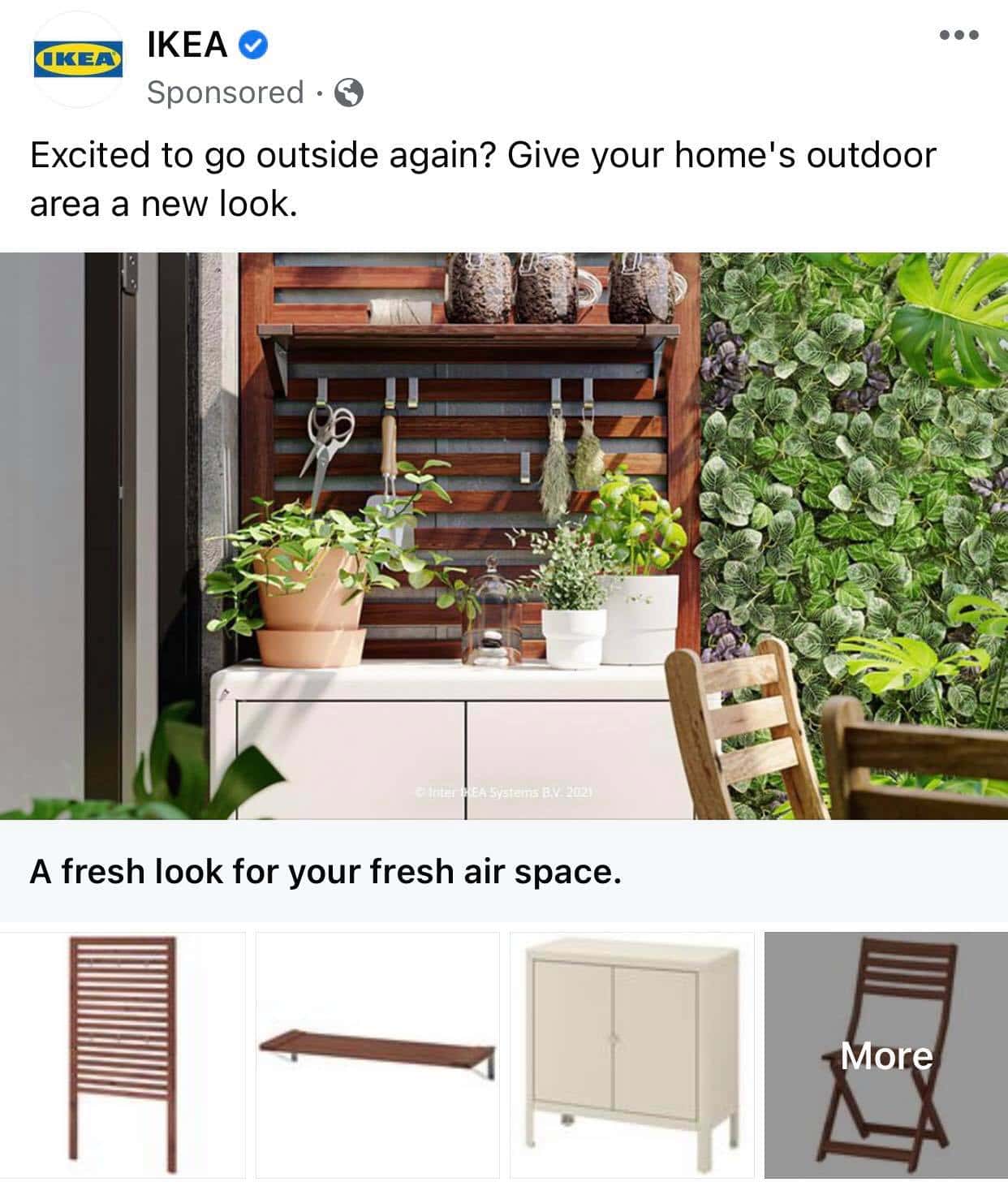
How many times have you seen an interior design setup and thought, “Tell me where I can purchase ALL THE THINGS. I want to recreate this!”
IKEA went with a visually-appealing “get the look” approach in this ad, which features a beautifully staged outdoor scene. Below, there’s a carousel of the items featured in the scene, and when you click “More,” you see larger images, model names, and prices.
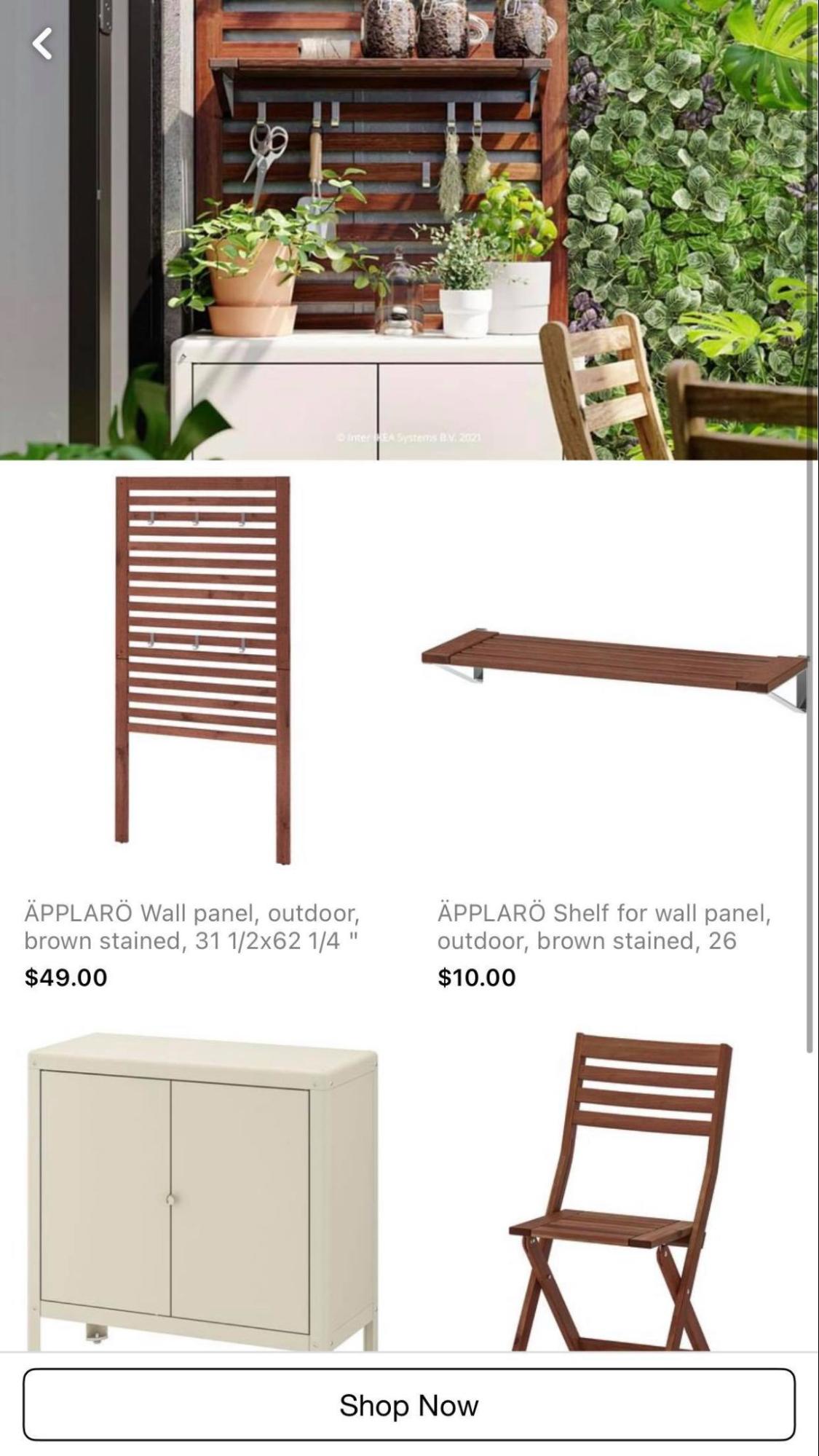
By adding this second page to the ad, IKEA is helping guide readers from awareness (“Whoa, that’s cool patio furniture”), to consideration (“That’s a good price for that chair”), and hopefully through to conversion, with the “Shop Now” CTA.
How To Water Your Plants From Bloomscape
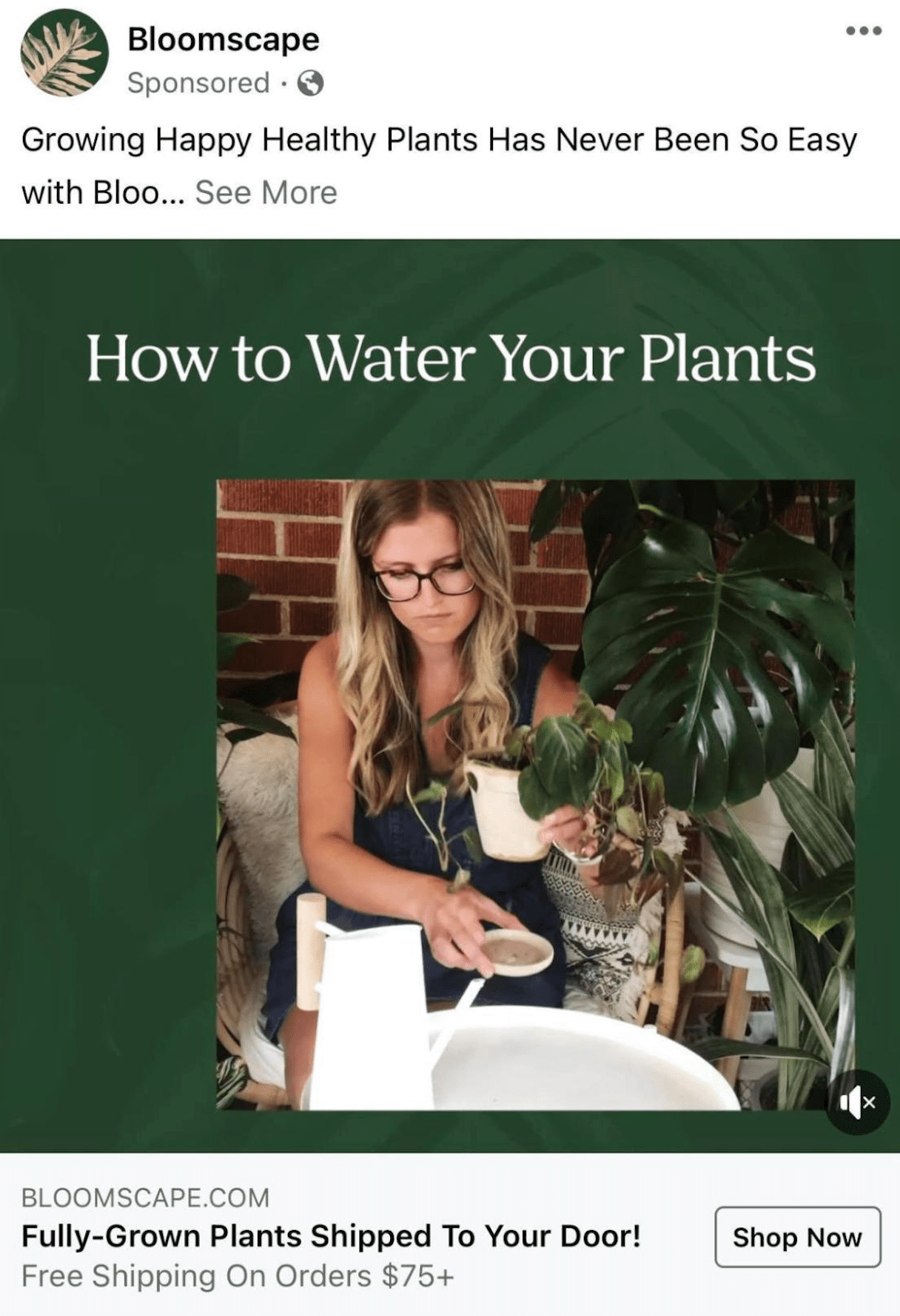
In this ad, Bloomscape used a short educational video to teach their target audience the proper way to water plants.
This ad is great for a few reasons. It focuses on a pain point of the target audience and offers an upfront no-click solution that establishes Bloomscapes’s authority and builds trust with the audience. Using a video—instead of images—also helps this ad stand out in an image-heavy feed.
Secretlab’s Top Rated Gaming Chair
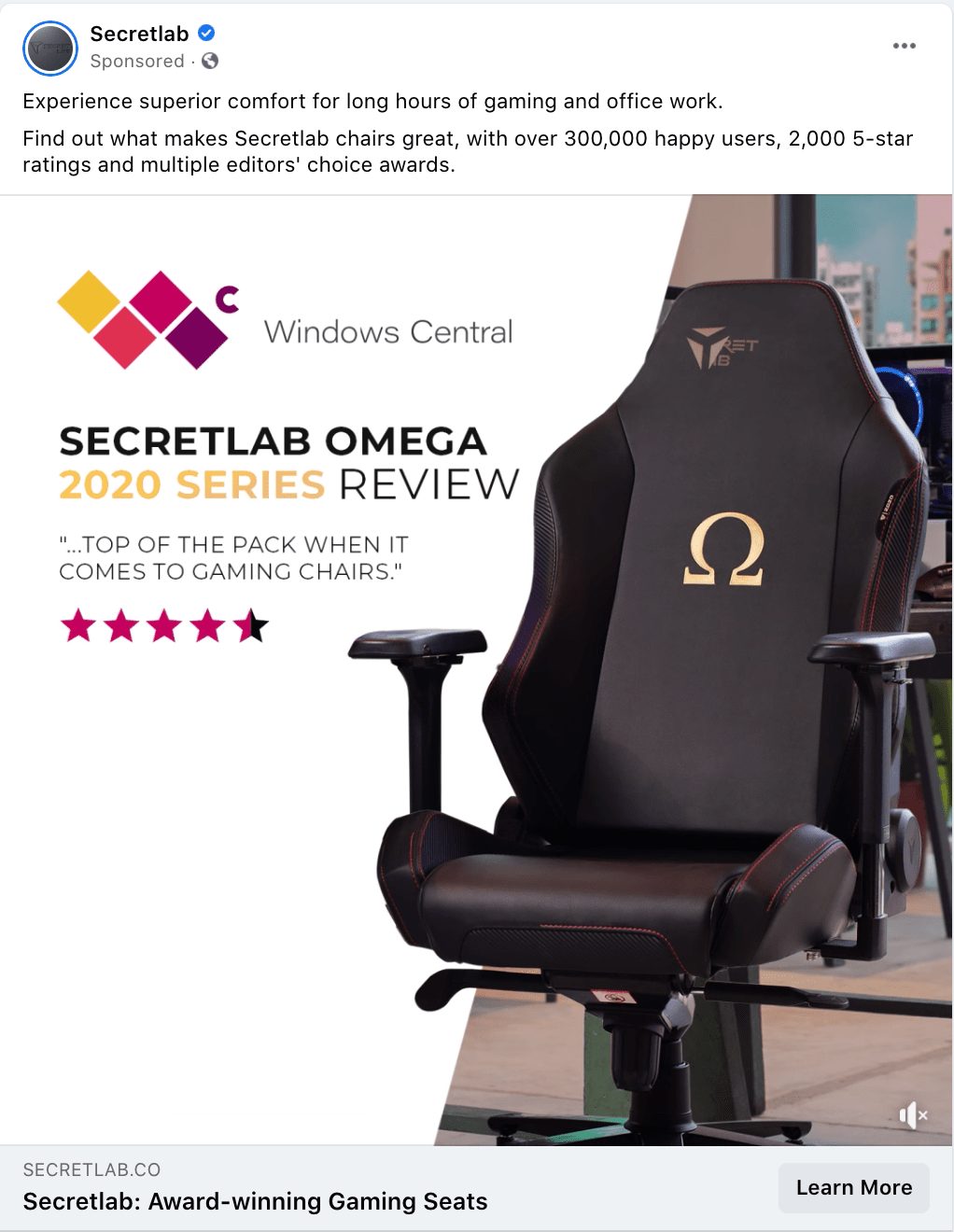
How many times have the reviews for a product influenced your purchase decision? “To buy or not to buy? That is the question.”
Knowing that people rely heavily on the word of others, Secretlab featured social proof snippets from the press and consumers to help persuade their audience to consider their chairs. The image is nothing special, but the copy’s mention of “300,000 happy users and 2,000 5-star reviews” creates equal parts FOMO and trust in the product’s quality.
Since their ad offered scant details about the product itself, the “Learn More” call-to-action button drives people to explore why these chairs are so highly rated.
If you’re not using reviews or testimonials in your ads, learn more about how to leverage social proof.
The Tatum Modular Collection from Interior Define
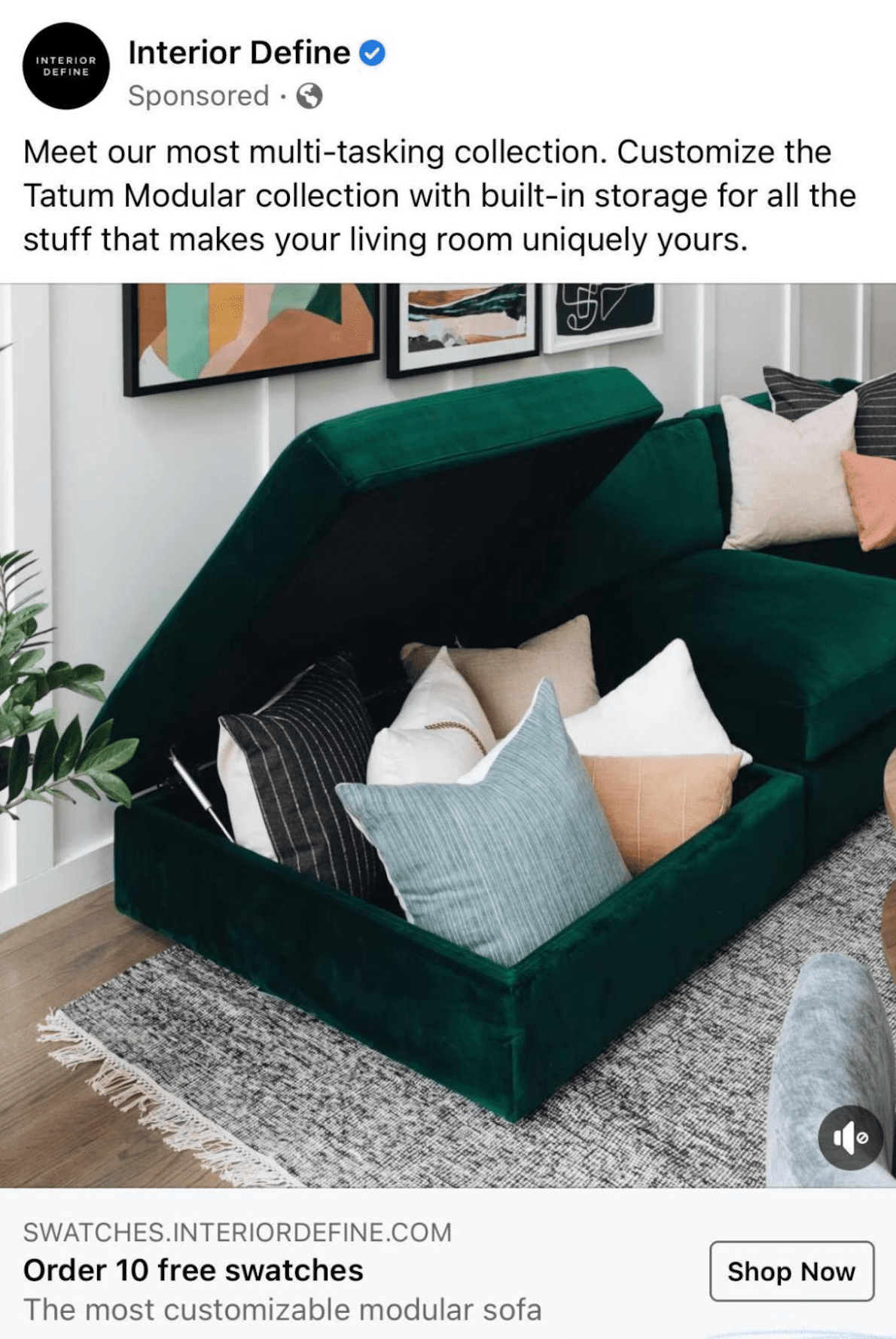
This ad from Interior Define captivates viewers’ attention with a unique image selection.
When the ad first comes through your feed, it appears to be a static image of an ottoman. After a few seconds, the ad image switches to a view of that ottoman open, revealing its storage feature. The motion of the GIF is certainly eye-catching, and once you’re hooked, the copy and CTA team up to seal the deal.
The ad copy up top emphasizes how customizable the collection is, while the copy introducing the “Shop Now” CTA prompts you to order your 10 free swatches to help you customize your eventual purchase. (Who doesn’t love “free?”)
Overtone’s Color Quiz for 20% off
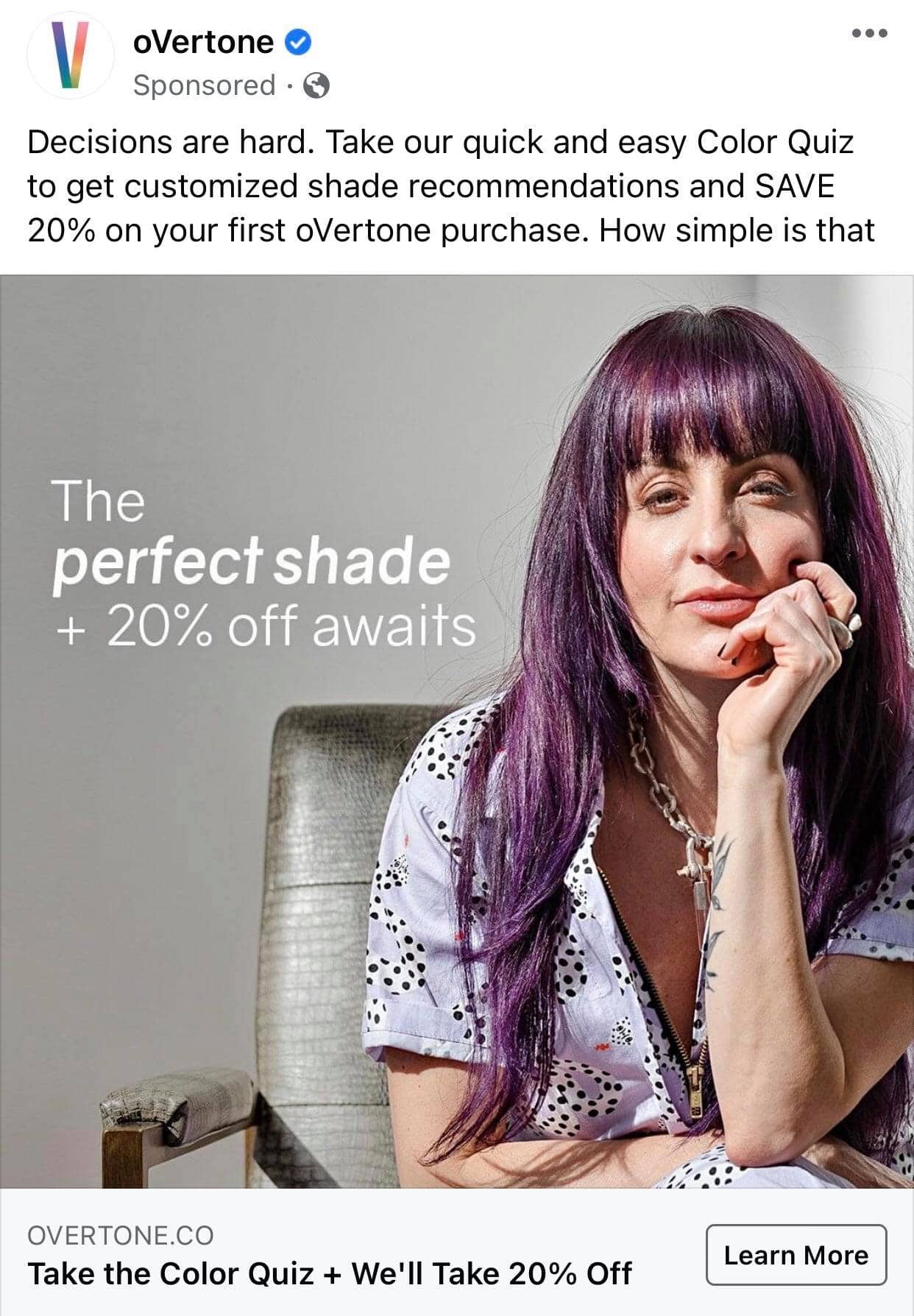
Overtone brings a promise of satisfaction in their Color Quiz ad. The static image features an oversized headline with the guarantee of the “perfect shade” and the promise of savings. (It helps that there’s a purple-haired model in the photo to catch your eye, too.)
The copy acknowledges the challenge of choosing your hair color and offers their quiz as a tool for alleviating that pain, showcasing their authority. The ad provides the added incentive of “20% off” for completing the quiz.
Tracking Your Facebook Campaigns
You’re not finished once you publish your ad. This is where the rubber meets the road.
Create multiple variants to test how ad performance is impacted by different:
- Ad Copy
- Ad Visuals (Imagery, Videos, GIFs, etc.)
- Calls to Action
You may find that static images are performing better than videos or that different CTA copy drives more conversions.
Once you find out what formula convinces users to click on the CTA, you can take it to the next level by optimizing your connected Facebook landing page:
- Build multiple landing page variants to test which converts Facebook traffic better.
- Create landing pages for different audience segments so you can match them to different ads targeting those same segments.
- Test whether the insights from your ads around copy and imagery performance carry over to your landing pages, or whether the landing pages require different imagery and copy to perform best.
One of the best ways to lose money in marketing is to generate tons of traffic with paid campaigns, only to have viewers lose interest when they visit your site.
No matter what targeting parameters you take advantage of and how you optimize your ads on Facebook, make sure you’re ready to nudge the buyers along their journey with a landing page that suits their needs.
If you don’t know what you should include in your landing pages to keep your audience engaged, try Smart Traffic to help you tailor your pages to every visitor.